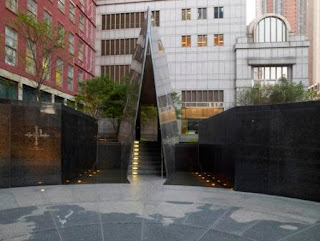Total Miles Walked To Date: 218.5 Miles
Total Miles Run To Date: 195.6 Miles
Total Miles Walk/Run To Date: 414.1 Miles
Saturday, February 28, 2009
Day 170 - February 27, 2009

On February 27, 2009 the Memorial Miles Team did their Monthly Group Walk to the National Monument The African Burial Ground located in Lower Downtown Manhattan.


Amadou & Paul - Cesar, Tom & Amadou
GSA’s African Burial Ground project began in 1991, when, during excavation work for a new federal office building, workers discovered the skeletal remains of the first of more than 400 men, women and children. Further investigation revealed that during the 17th and 18th centuries, free and enslaved Africans were buried in a 6.6 acre burial ground in lower Manhattan outside the boundaries of the settlement of New Amsterdam, which would become New York. Over the decades, the unmarked cemetery was covered over by development and landfill. Managed by GSA, the overall project is a testimonial to a positive and collaborative partnership between many parties, including the Department of the Interior’s National Park Service, the U.S. Army Corps of Engineers, the Advisory Council on Historic Preservation, Howard University, the Schomburg Center for Research in Black Culture, and the African American community.Today the site is a National Monument featuring a distinctive memorial that commemorates and communicates the story of the African Burial Ground—the single-most important, historic urban archaeological project undertaken in the United States.
A Sacred Space in Manhattan
From the 1690s until the 1790s, both free and enslaved Africans were buried in a 6.6 acre burial ground in Lower Manhattan, outside the boundaries of the settlement of New Amsterdam, later known as New York. Lost to history due to landfill and development, the grounds were rediscovered in 1991 as a consequence of the planned construction of a Federal office building.


A Sacred Space in Manhattan
From the 1690s until the 1790s, both free and enslaved Africans were buried in a 6.6 acre burial ground in Lower Manhattan, outside the boundaries of the settlement of New Amsterdam, later known as New York. Lost to history due to landfill and development, the grounds were rediscovered in 1991 as a consequence of the planned construction of a Federal office building.


Kamram, Tom & Amadou
The Memorial: Designed by RodneyLeon, Architect
A memorial at the African Burial Ground National Monument honors the memories of the estimated 15,000 Africans buried at the approximately seven-acre site in the 17th and 18th centuries. The memorial opens daily at 9:00 a.m. and closes at 5:00 p.m except for Thanksgiving, Christmas and New Year's Day.
The Visitor Center
The Visitor Center contains exhibits and replica artifacts, and provides educational programs and interpretation of commemorative art commissioned for the African Burial Ground.
Because the Visitor Center is in a Federal office building, visitors must go through airport-style screening before entering.
The African Burial Ground National Monument, located at the corners of Duane and Elk Streets in lower Manhattan, is operated by the National Park Service. For directions to the site and more information, go to www.nps.gov/afbg
The Visitor Center contains exhibits and replica artifacts, and provides educational programs and interpretation of commemorative art commissioned for the African Burial Ground.
Because the Visitor Center is in a Federal office building, visitors must go through airport-style screening before entering.
The African Burial Ground National Monument, located at the corners of Duane and Elk Streets in lower Manhattan, is operated by the National Park Service. For directions to the site and more information, go to www.nps.gov/afbg
Did You Know?New York's African Burial Ground is the final resting place of approximately 15,000 free and enslaved Africans. Dating from the late 17th century. It has been called one of the most important archaeological finds of our time.
Subscribe to:
Comments (Atom)







